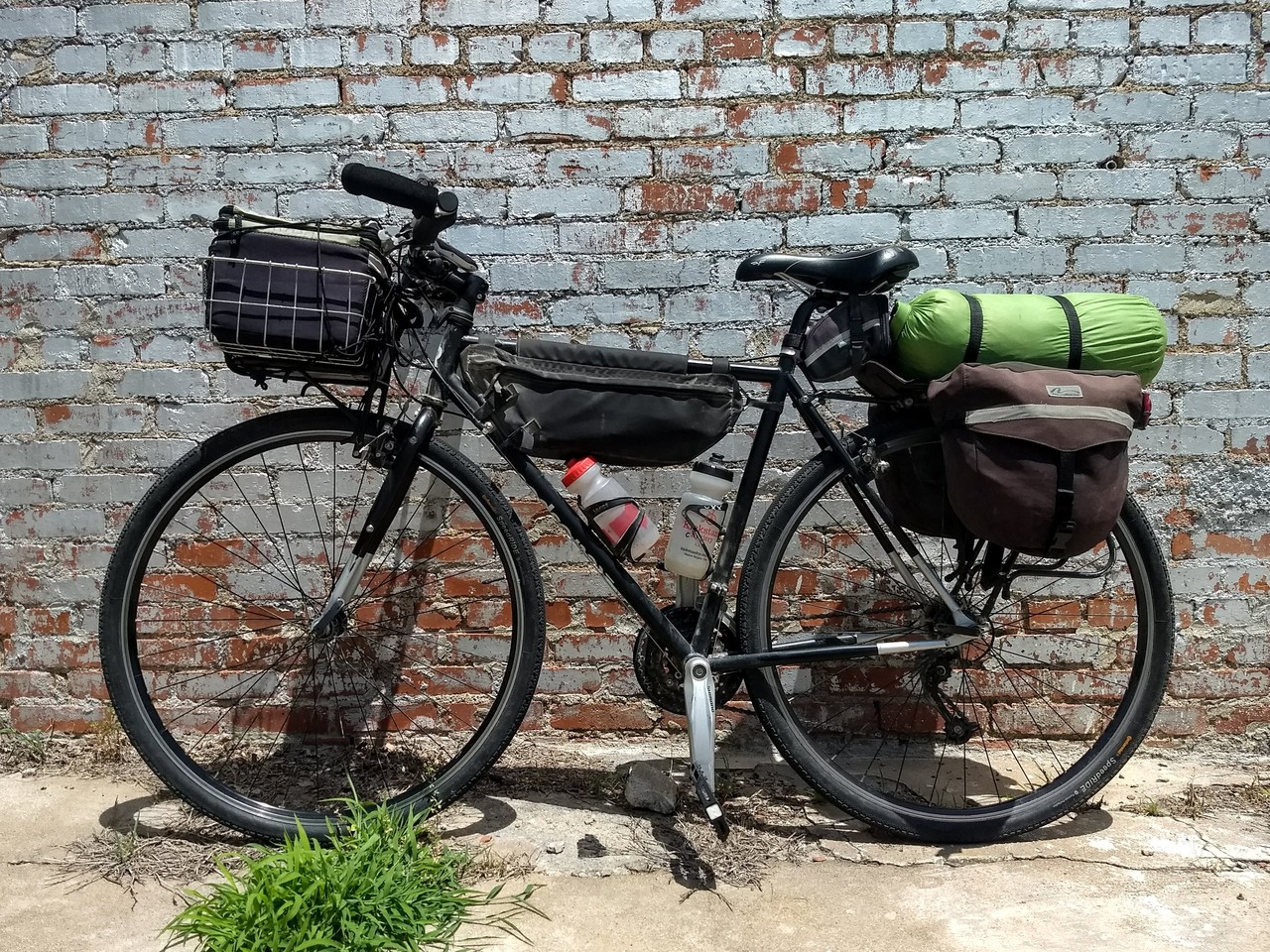I’m still exploring my options when it comes to traditional bicycle touring (racks and panniers) vs. newfangled bikepacking setups (soft bags). So as any self-respecting bike nerd will do, I created a spreadsheet, and started plugging in numbers.
First up, my current touring setup (looking just at the hardware, ignoring the contents):
- Axiom Journey Rear Rack: 700g
- Sunlite Front Rack: 189g
- Wald 137 Basket: 998g
- Ortlieb Backroller Panniers: 1900g (40L)
- Soft Cooler: 180g (4L)
- Seat Bag (tool/tube bag): 100g (1L)
- Jandd Frame Pack Large: 181g (4L)
- Total: 4250g = 9.37 lbs, for about 49 liters capacity
Next up, a rough bikepacking setup:
- Kada Pack Ratt Seat Bag: 460g (10L)
- Topeak FrontLoader w/bag: 386g (10L)
- Jandd Frame Pack Large: 181g (4L)
- Moosetreks Stem Bag (2): 228g (2L)
- Salsa Anything Cage HD (2): 298g
- Salsa Anything Bag (2): 440g (9L)
- Revelate Gas Tank Top Tube Bag: 100g (1L)
- Total: 2091g = 4.61 lbs, for about 36 liters capacity
Next up, a sort of hybrid system, utilizing micro panniers, but keeping the front basket:
- Axiom Transit Rear Rack: 550g
- Sunlite Front Rack: 189g
- Wald 137 Basket: 998g
- Nashbar Daytrekker Panniers: 425g (12L)
- Soft Cooler: 180g (4L)
- Seat Bag (tool/tube bag): 100g (1L)
- Jandd Frame Pack Large: 181g (4L)
- Total: 2622g = 5.78 lbs, for about 21 liters capacity
And finally, another hybrid setup, this time using a handlebar bag:
- Axiom Transit Rear Rack: 550g
- Nashbar Daytrekker Panniers: 425g (12L)
- Roswheel Compact Handlebar Bag: 320 (5L)
- Seat Bag (tool/tube bag): 100g (1L)
- Jandd Frame Pack Large: 181g (4L)
- Moosetreks Stem Bag (2): 228g (2L)
- Total: 1805g = 3.98 lbs, for about 24 liters capacity
So the way I’m looking at it right now, I’m not convinced that the seat pack is preferable to a rack and panniers. A seat pack is very inflexible — it’ll fit a given amount, but not much can be added. Any carrying flexibility needs to be up front — handlebar roll and fork-mount bags.
A rear pannier, on the other hand, provides all kinds of flexibility. You can attach panniers of various sizes, plus you have the rack platform to strap on a tent or sleeping pad. Then up front, you can go with either a more flexible setup (basket), or a less flexible setup (handlebar bag, plus stem bags, plus optional fork bags).
Under these scenarios, the second hybrid setup (light rack, micro panniers, tent strapped to rack, handlebar bag, stem bags) is actually the lightest configuration. Capacity is probably sufficient for summer touring. If I need cooler-weather gear (more clothing, better sleeping bag), I can step up to slightly larger panniers (e.g. Arkel Dry-Lites at 540 grams for 28 liters), or all the way up to the heavy Ortlieb bags.
Given that my typical tours are more roadish (pavement, gravel, or rail-trails) than singletrack, panniers should not be a problem in terms of bike handling or hike-a-bike.
Also, I already own the racks and panniers, but I’d need to purchase some of the bikepacking bags, so that’s a factor to consider, as well.
Anyway, that’s what I’m thinking at the moment. I’m hoping to try the micro-pannier/handlebar-bag setup on a short tour soon!
Here’s the Amok setup with the micro panniers and front basket:

This is with an inflatable sleeping pad rolled up with the tent. Alternately I could strap a foam pad on top of the tent (or onto the front of the basket).
I haven’t set it up with the handlebar bag yet (waiting on a part to come in), but am confident that it’ll work fine, at the cost of a bit of flexibility. Likewise, I haven’t yet bothered to swap out to the lighter rear rack.